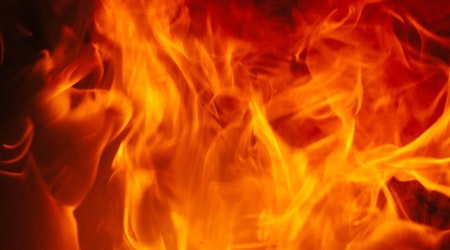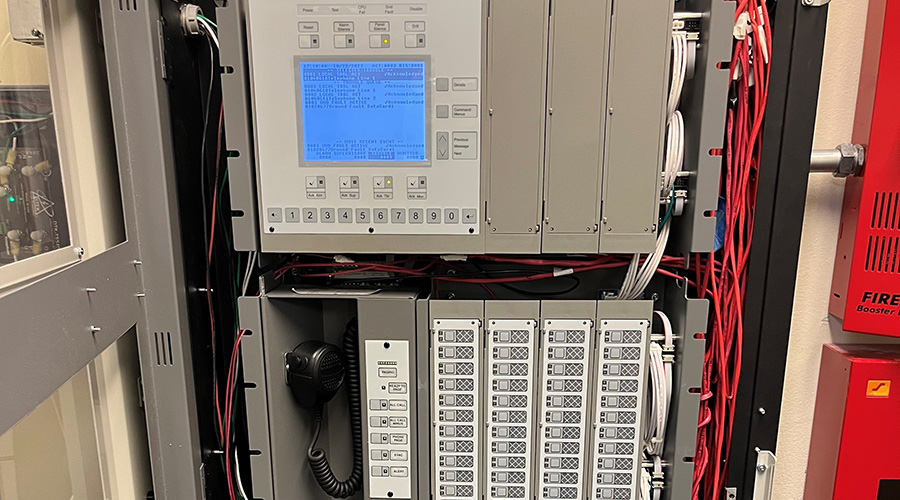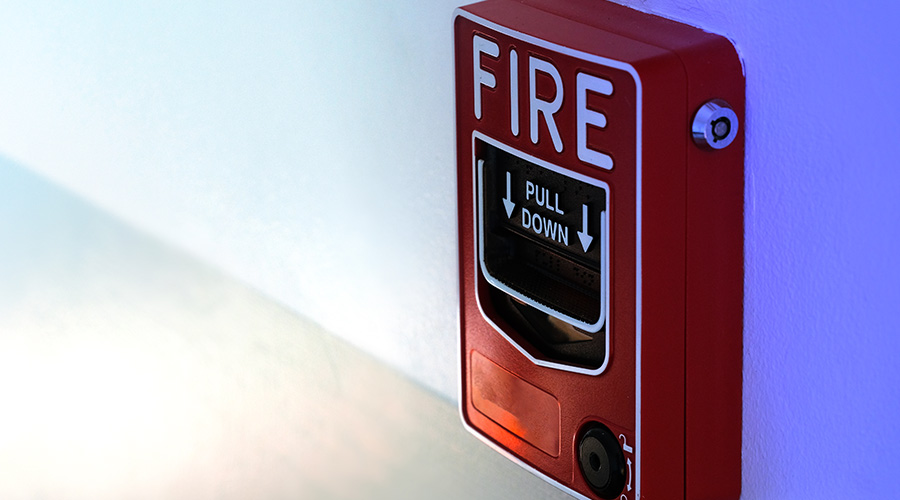Balanced Approach to Fire Safety
When it comes to protecting people and property, a mix of active and passive fire protection measures is the best choice
Though fires in commercial, institutional and industrial facilities account for only 8 percent of all fires in the United States, those fires were responsible for $2.8 billion in property losses in 2000, the most current year data is available from the U.S. Fire Administration. Those fires also caused 90 fatalities and 2,200 injuries.
No one knows how many fires are not reported because fire protection systems handled the situation. What is known is that the number of fires and the number of deaths have declined dramatically over the past two decades, thanks to the combined efforts of firefighters, code officials, fire protection engineers and facility executives.
No one measure guarantees protection should a fire break out. Balanced fire protection design blends alarming systems with active fire fighting steps, notably fire sprinklers, as well as passive measures such as fire-resistive building materials like firestopping; compartmentalization; fire-rated floors, walls and doors; pressurized stairways; and other elements.
Role of Alarms
The alarm system automatically detects a fire and alerts occupants, the fire department and the facility staff. “Fire alarm systems are the core of life safety in buildings and fire safety design,” says James Carrigan, associate partner and supervising engineering of fire/life safety for Syska Hennessy Group.
The specific form the alarm system will take is spelled out in fire codes. Like the rest of the balanced fire protection system, the kind of alarm system is dictated by the type of building and its occupancy. High-rise office buildings have different requirements than low-rise retail stores. Hospitals, where the patients often are unable to exit on their own, have more extensive requirements. Educational, public assembly and storage buildings are addressed separately by codes.
In more sophisticated applications, the alarm system interfaces with nearly all major building systems, including HVAC, vertical transport, security and plumbing.
“The alarm system can shut down a portion of the HVAC system so that fresh air is not being supplied to the fire,” says Carrigan. “It can control the elevators, recalling them to the lowest floor. And it can override the security system so that people can exit the building. It even can monitor exactly where a sprinkler head has activated to assist in fighting the fire.”
Despite all these advantages, alarm systems were not present in most reported non-residential structure fires, according to the U.S. Fire Administration/National Fire Data Center’s report, “Non-Residential Structure Fires in 2000,” released in June 2004.
“No smoke alarm was present in 72 percent of non-residential structure fires; alarms were present and operated in only 17 percent of non-residential structure incidents,” says the report. “From these statistics, it can be inferred that working and effective smoke alarms in non-residential structures are detecting fires, which are then extinguished before it is necessary to report them. Another possibility is that non-residential structures with alarms — evidence of responsible building management or compliance with fire codes — also have comprehensive fire prevention plans that are effectively working in preventing fires.”
Role of Sprinklers
While smoke and fire alarms are the first alerts to a fire situation, the sprinkler system actually begins fighting the fire before the fire department arrives. “In the last 30 years, we’ve seen more emphasis on balancing,” says Kevin Kelly, manager of codes for the National Fire Sprinkler Association. “Today, we’re finding more occupancies — notably motels, hotels and dwelling places — recognizing the life safety features of sprinklers.”
“There are different types of sprinklers for different areas and occupancies,” says Kenneth E. Klein, vice president at Syska Hennessy Group. In some newer systems, for example, water is under tremendous pressure so that it is released as a fine mist. “This technology is being used in smaller computer rooms, because it uses less water, and one of this occupancy’s biggest problems is water damage.”
“U.S. Experience with Sprinklers” from the Fire Analysis and Research Division of the National Fire Protection Association (NFPA) notes that, where sprinklers are present, the chance of dying in a fire and the average property loss per fire are both cut by 50 to 67 percent, compared to fires where sprinklers are not present. This comparison, of course, is limited to fires reported to fire departments.
Many fires, where only one sprinkler is required to control the fire, are not reported to fire departments, according to FM Global’s research center. According to FM Global, which has been charting and recording sprinkler performance for more than 100 years, it takes one to five sprinklers to control 75 percent of all fires large enough to report. FM research spanning 3,292 fires between 1970 and 1977 suggests sprinklers are 85.8 percent successful. NFPA data from 1964 to 1977, covering 81,425 fires, suggests the sprinkler success rate is 96.2 percent.
“We have never seen multiple fatalities in a sprinklered building in which the system was not otherwise impaired,” says Gregory Harrington, principal fire protection engineer for NFPA. “Of course, we are talking about normal fire situations and excluding major explosions or terrorist attacks.”
Code Perspective
Confidence in the ability of sprinkler systems to control many fire situations is recognized in both NFPA’s fire codes and those of the International Code Council (ICC).
Jim Tidwell, national director of fire service activities for ICC, says that sprinklers are a very important component of fire safety. “But building owners and developers need to understand that balanced fire safety requires a systems approach to addressing the hazard of fire,” he says.
Because of the effectiveness of sprinkler systems, codes often allow trade-offs or trade-ups on other elements of the fire protection system. “If a building is fully sprinklered, the codes permit extended travel distances to exits, reduced fire-resistive construction and a reduced number and location of fire blocks,” says Jeff Harper, vice president and engineering manager for the Chicago office of Rolf Jensen Associates. “That’s because the effectiveness of sprinklers allows building occupants more time to exit the building.” Although compartmentalization and other passive fire protection features may not be as robust as in a non-sprinklered building, Harper says, they are still present.
One reason is that sprinklers sometimes fail to operate. Specific models have been recalled by the Consumer Product Safety Commission. Microbial-induced corrosion also can occur inside the water pipes as a result of bacteria attacking the interior surfaces. Inadequate inspection and maintenance practices can lead to failures. When the sprinkler system’s water flow is shut off or the facility loses its water supply, the system is compromised.
Learning from Experience
Fire sprinklers also can be overwhelmed when actual fire loads are higher than the system was initially designed to address, as seems to have happened with Buildings 5 and 7 of the World Trade Center complex on Sept. 11.
“Building 7 is not believed to have been seriously impacted by the collapse of the towers; Building 5 did have some severe damage from falling debris, but much of the building was undamaged,” reports W. Gene Corley, Team Leader, World Trade Center Building Performance Study. “Both buildings had sprinkler systems. Yet Building 7 and a portion of Building 5 collapsed from burnout fires. The sprinklers in Building 5 were overwhelmed by the intensity of the fire; and there was either no water supply or insufficient water to combat fire and prevent collapse of Building 7.”
This and other studies are being evaluated by the technical committees of fire code organizations, says Harrington of NFPA. “We are evaluating what happened on Sept. 11, and the committees are wrestling with ways to improve the code.” Items being reviewed include improving the structural stability of stairwells and providing wider exit stairs. Increasing the exit stairwells enclosure requirements by requiring cinder block or concrete in lieu of wallboard also are being considered for future editions of the fire code.
ICC also is looking at World Trade Center research being conducted by the National Institute of Standards and Technology (NIST), says Tidwell. “The NIST research should provide information that code writers can tweak to provide appropriate fire protection. Early information indicates that the fire loads were greater than had been anticipated.”
Role of Protected Construction
Even the best alarms and sprinkler systems will never be able to stop all fires. That’s why passive fire protection is also important. Passive fire protection measures help confine flames and smoke so that the fire remains as manageable as possible. The use of compartmentalization measures such as fire-rated walls, doors and enclosures, supports active systems such as sprinklers in the effort to control a fire. Passive fire protection also is designed to guard the structural integrity of the building and the spaces that occupants use to move to safety.
“Built-in fire-resistive construction has been historically required primarily to separate buildings from one another, to separate building uses, to protect the structural elements, to protect tenants from one another, to protect egress paths from smoke and fire, etc.,” says Vickie J. Lovell, president of the Alliance for Fire Safety. Lovell is a building code consultant and president of InterCode.
“Fire safety cannot be an ‘either-or’ proposition,” Corley says. “Buildings for which sprinklers are appropriate should also have fire-resistant construction for better fire protection. Anything less puts occupants and emergency responders at risk and is therefore unacceptable.”
Chris Jelenewicz, engineering program manager for the Society of Fire Protection Engineers, agrees: “We should never rely on a single fire protection feature any more than we would rely on just the air bag or the antilock brakes in our cars. The air bag is a great invention and definitely saves lives, but we still need our seatbelts.”
Whatever combination makes economic and practical sense to protect a building and its occupants from the ravages of fire, the balanced fire safety package needs regular inspections and attention. “Quite often when we do inspections, we find major holes in fire walls, or fire proofing on structural columns or beams has been removed or replaced,” Harper says. “When fire doors are propped open, the fire wall is effectively useless.”
Like sprinklers and alarms, protected construction needs regular attention and examination. Regular inspections of the full fire protection system — from the alarms and sprinklers to fire-resistive construction details, fire doors and stairwell exits — is essential.
Role of the Facility Executive
“The maintenance of both active and passive systems ensures that a relatively small fire is contained by the floors, walls and ceiling and is controlled by sprinklers, and that the smoke does not migrate from the room (or the floor) of origin,” says Lovell. She points out that when a fire can be contained within a single compartment of a building and controlled by a single sprinkler, the water from the sprinkler, the fire and the smoke may have an insignificant impact on building operations. “Such fires are often not even reported to the fire department,” she says.
It’s a different story when fire and smoke spread from room to room through compromised fire-rated assemblies, so that the blaze activates more than one sprinkler, or when a sprinkler fails to operate satisfactorily. In those cases, the fire department will be required to extinguish the fire. “Aside from the more important life safety issues, this scenario can result in months of interruption of services. In fact, some businesses never recover,” says Lovell.
While smoke alarms may be the first to sound, most experts agree that they are only one segment in an integrated system of fire protection. In balanced fire safety designs, multiple methods and materials are used to reinforce a facility’s fire protection system.
“This means that success is not measured by the extent of use of any one technology or system or code,” write the National Fire Protection Association’s “Fire Protection Handbook” authors John R. Hall, Jr. and Arthur E. Cote. “Success is measured by the extent of usage of effectively designed, integrated fire protection systems. No one system should be considered disposable, and no one system should be considered a panacea.”
Rita Tatum, a contributing editor to Building Operating Management, has more than 25 years of experience covering facility design and technology.
Related Topics:












